
An easy day-trip from the city of Pune are two sets of Buddhist cave complexes, at Bhājā and Karlī (now known as Karla). I could flat-footedly describe them as monasteries carved out of the mountains, but what was important about visiting here will be harder to convey. I will try, but first, some basic facts: These elaborate structures were built by removing rock from the mountain, leaving in place large open spaces, some with high arched ceilings, dramatic colonnades and some lovely wall-carvings.

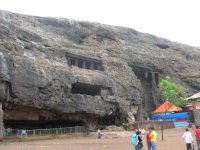
At both complexes, the long vaults of teak wood that decorate the ceiling of the central hall are said to be original. But especially what the artisans made of these mountains were monastic living quarters. About half the caves were monastic residences.
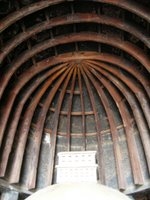
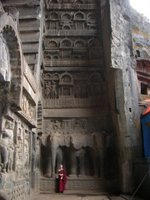 Buddhist monks first moved in to them some 2,100 years ago, according to archeologists who date the sites to the two centuries before the common era (160 BCE and 80 BCE are dates commonly given). In some cases, living quarters are carved out of the walls of a large gathering space; in some cases there are multiple stories of quarters, usually quite tiny, connected by winding stairways of stone.
Buddhist monks first moved in to them some 2,100 years ago, according to archeologists who date the sites to the two centuries before the common era (160 BCE and 80 BCE are dates commonly given). In some cases, living quarters are carved out of the walls of a large gathering space; in some cases there are multiple stories of quarters, usually quite tiny, connected by winding stairways of stone.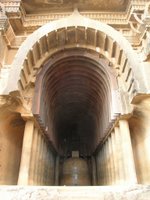
It is hard to fathom the effort it must have taken to wrest these elaborate spaces from the rock, but the strategic placement of these complexes is confirmed by the sight of two long stone forts built at the peaks of two surrounding passes. I made the trip to visit these caves recently with Neil Dalal, another Fulbrighter here in Pune. Neil is a deeply thoughtful student of Vedanta, and made a wonderful traveling companion for this excursion.
There is something extraordinary that can happen simply being by physical present at places that were important to the people who occupied them. Not always, but sometimes, and sometimes this ‘something’ defies our ordinary understanding of the shape of time, and this is especially so if one knows that one is in a place lived in for long periods of time in the past by humans for whom they were deeply meaningful. At least that was the case for me here.


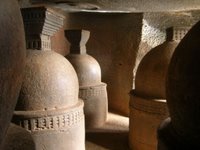
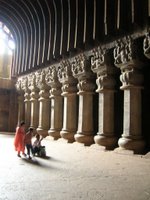
There have been times in Pune - not a city in which Buddhist monks are likely to be seen wandering - when my own monastic robes and vows have seemed out of context. Without a context - a context that most often is provided simply by being in a Buddhist community - the purpose and meaning of those vows can easily lose its clarity. Sitting here, even without any other actual members of the monastic community, that context was fully present for me.
These Buddhist sites caves apparently do not see many visitors most days, though those who do come seem unusually interested in shouting into the caves for the acoustic effect. A temple to the goddess Ekvira, built literally at the doorstep of the main Buddhist cave, draws Hindu pilgrims, but these seldom seem to visit any but the largest Buddhist cave. Across the valley, Bhājā was nearly deserted when we arrived, save for two elderly attendants. Here, Neil and I were each able to take a good stretch of time to just sit silently, each in our own monastic cell.

In one of the photos that I will be posting towards the bottom of this blog entry, you can see the bed (or so I understand it) of rock left in the cell when the rest was carved out. Removing my shoes and entering, I sat down where some other monk must surely have sat in a past I can only reach in my imagination. Actually, since the caves were in use for many centuries, dozens of generations of monks certainly must have sat there. In my robes, holding vows that may have passed received through their lineage, I sat and tried to connect with the other monks who sat there, perhaps arguing with their friends, meditating, reading, sleeping, or like me resting my eyes on the long and lush green view out the door to the cell, wondering about others who had been there before. Or perhaps they wondered about those who would come in the future, in their future that was now my present. Nurturing, protecting and transmitting the teaching of the Buddha as a way of caring for future generations is a prominent part of some Buddhist practices, as is cultivating gratitude for those who have done so for you in the past. And so the monks and I sat in those small quarters, wondering about each other, caring for each other and feeling thankful for the care received.



2 comments:
This was such a great post.. Made the past come alive, and also makes you realize how much has been lost.
Hi Damcho,
Thanks for a beautifull write with photgrpahs.
Iam myself a Buddhist practising Nichiren Buddhism studying the Lotus Sutra with Soka Gakkai international and called Bharat Soka Gakkai in India. I truly realize as Buddhist and a human being, gratitude is extremely important... I really thank youf rom the bottom of my heart for such a thought provoking write up.I might visit this place this month. I shall post some pictures and write up as well..Many Thanks,
Prashanth.K.P,
Nam-myoho-renge kyo
Saddharma Pundarika Sutra
Post a Comment